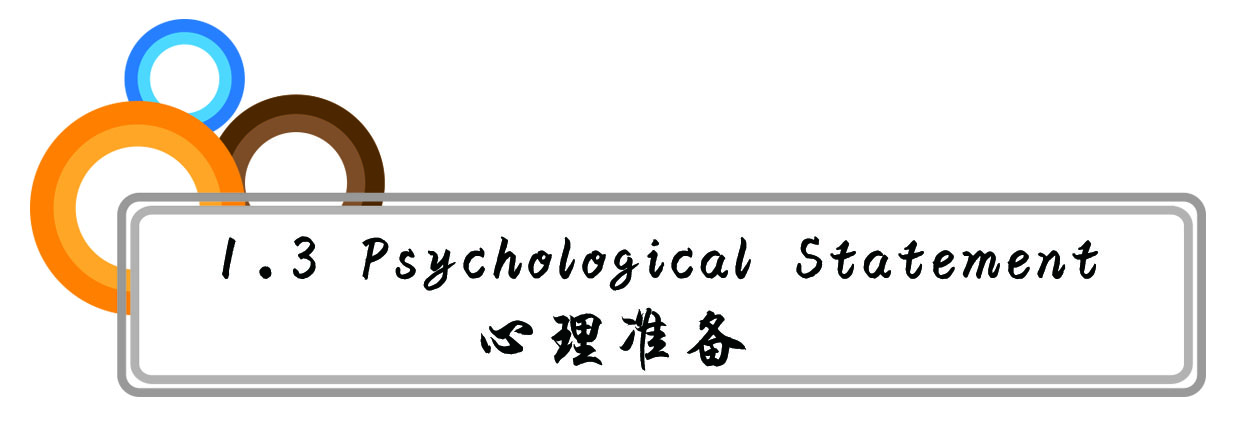
吧


(1) Fully read and comprehend teaching materials;
(2) Thinking the following questions:
● For whom to teach?
● Why to teach?
● What to teach?
● How to teach?
● How long to teach?
● When and where to teach?
(3) Design the following items for a lesson plan
Theoretical basis, analysis of material and the learners, teaching objectives, teaching focus and anticipated difficulties, teaching and learning method, teaching aids, teaching procedures and duration

In class, making decisions should always be finished within instance, and “teachers’ explanations are often not as clear to their Ss as they are to themselves! It is worth preparing.
Thinking about the words you will use, the illustrations you will provide,
(1) Check the real objects you will show;
(2) Check PPT documents and the layout of blackboard;
(3) Review the procedure you will adopt and the scaffolding you will facilitate.
You may write a list out.

明确所有物质准备均以教师良好的心理状态为前提,没有机器可以取代教师。

● Creating the atmosphere of learning English
● Gaining Ss’interests & attention
● Stimulating Ss’motivation
● Developing the interaction between the T & Ss


Some learning activities that can get students ready mentally and psychologically for learning, help build up a bridge between prior knowledge and new knowledge. The characteristics of lead-in are meaningful, interesting and it can build upon students’ prior knowledge or personal experience and build upon students’ learning preferences

● Gaining attention
● Arousing motivation (Stimulating Ss’ learning desire)
● Activating Ss’ learning schema (Making links)
● Structuring

(1) Employ motivational techniques to arouse students’ interest;
(2) Activate students’ background knowledge;
(3) and help build up background for the new concepts;
(4) Help students anticipate what they will be learning;
(5) Give clear & careful directions about what needs to be done;
(6) Introduce technical or difficult vocabulary.

You do not have to have a loud, booming voice, but you need to be heard by all the students in the room. Nonverbal messages are very powerful. Here are some pointers:
(1)Let your body posture exhibit an air of confidence.
(2)Your face should reflect optimism, brightness, and warmth.
(3)Use facial and hand gestures to enhance meanings of words and sentences that might otherwise be unclear.
(4)Make frequent eye contact with all students in the class.
(5)Do not “bury yourself” in your notes and plans.
(6)Do not plant your feet firmly in one place for the whole hour.
(7)Move around the classroom, but not to distraction.
(8)Follow the conventional rules of proxemics (distance) and kinesthetic (touching) that apply for the culture(s) of your students.
(9)Dress appropriately, considering the expectations of your students and the culture in which you are teaching.


利用新旧知识的联系,从旧知中引出新知的一种导入方法。知识是连贯的,系统的,新知识是在旧的基础上发展起来的。导入新的语言知识和技能前需要有意识地选择一些与新知具有内在联系的已学知识,或进行对比,或进行 “连珠炮似的问”(Questionbombardment)、或运用“大脑风暴法” (Brainstorming),来唤起学生对已学知识的回忆,提供新、旧知识联系的支点,以旧带新,自然过渡,达到温故而知新的目的,并使学生能在轻松愉快的气氛中学习知识并使之系统连贯。

教师通过语言、声像、直观教具等手段和条件,为学生创设贴近教材内容和实际生活的情景,使学生身临其境,从而唤起学生情绪体验和情感反应,使学生自然而然进入学习情景的一种导入方法。真实生动的语境能吸引学生参与,调动学生的积极性,使学习语言的过程变得生动有趣,为新材料的呈现铺设环境,使学生在一定的语境中感知和理解新语言材料的意义、用法和功能,理解具体情境中语言传递的信息。

教师借助图片(包括插图、多媒体图片、照片、简笔画等)或实物等辅助手段具体化、形象化地引出新知识的一种导入方式。这些辅助手段主要有:黑板、白板、卡片、简笔画、教学挂图、模型、实物以及多媒体等。直观导入可以使抽象的知识具体化、陌生的知识形象化,易于帮助学生理解所学的语言知识。这是一种适用性广、教学效率高的方法。

使用讲述与课堂内容相关的事件进行导入的方法。它侧重于事件过程的描述,强调情节的生动性和连贯性,使用学生已学的语言表达,适于口头讲述。故事既可以是真实的也可以是虚构的。目的在于通过有趣或特殊的情节引起兴趣和关注,继而了解即将学习的材料的背景知识、相关内容等,为进一步学习新知降低难度

教师通过介绍与新课内容相关的文化背景来导入的方法。这些文化背景知识包括政治、经济、地理、历史、文艺、宗教、习俗、礼仪、道德、伦理及社会生活的各个方面。这些宏观背景能帮助学生构建图示,减少听力和阅读时语言材料所表达的意义障碍和学习过程中的思维障碍,提高学习效果。

在新材料呈现之前,教师结合所学内容,围绕一个或多个话题,与学生使用目的语进行“自由”交谈,从而导入新课的方法。交谈话题广泛,既可以是日常活动,也可以是新闻、热点问题或是学生感兴趣的其它话题,如球赛、旅游等。话题组织方式既可采取师生交流式,也可以分组汇报、组间竞赛等方式进行。使学习者在愉悦、轻松的交流中不知不觉进入新学材料的语境中。

在呈现新知前通过组织生动有趣的游戏或紧张激烈的竞赛,复习调动已有知识技能,为新课作铺垫的导入方法。常见的有:猜一猜、做一做、赛一赛、演一演等。游戏具有很强的趣味性,适合孩子的心理与年龄特征。利用游戏来进行导入易于活跃课堂气氛,增强情感体验,还能培养竞争意识,促进团队合作,增强学习信心。是一种寓教于乐的好方式。

Lewis, M. & J. Hill. Practical techniques for language teaching [M]. Beijing: Foreign language teaching and research press & Cengage learning, 2009:49-54
肖惜. 教师职业技能训练简明教程 [M]. 北京:高等教育出版社,2002:115-121.

Q1: Why don’t we present new knowledge directly?
Q2: How to prepare yourself for lead-in at the stage of pre- lesson?
Q3: What are characteristics of lead-in?
Q4: How many ways can we utilize to lead in?























